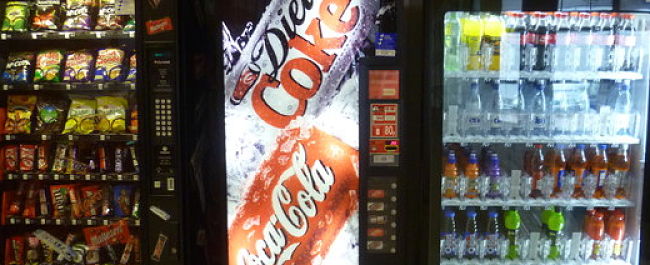Delivering public health outcomes: vending machines should stock healthier food and drinks

Our environment influences what we eat. The Government’s National Planning Practice Guidance outlines the importance of ‘planning for an environment that promotes access to healthier food’. Foods sold in vending machines in hospitals, workplaces and recreation facilities are obesogenic (likely to contribute to obesity), as they are energy dense (more calories per bite), high in fat and sugar and low in fibre.
About the research
The availability of energy-dense, low-nutrient foods and drinks from vending machines is linked to higher body weight among children. This evidence, alongside the Government’s recent Childhood Obesity Strategy, means that it is crucial that the balance of foods provided in vending machines is improved and the provision of healthier products is promoted.
Drawing on research from the Centre for Exercise, Nutrition & Health Sciences, this briefing highlights that foods and drinks sold in vending machines contribute to a hostile environment for healthy eating, by making obesogenic foods readily available. Our evidence can be used to support leisure operators, schools, worksite catering procurement managers, food vendors, Local Government Associations and Wellbeing Boards to improve the balance of products provided in vending machines (e.g. in leisure venues, hospitals and workplaces), as a way to tackle obesity.
Policy implications
• Based on their current nutrient composition, most snacks and drinks in vending machines should be consumed rarely and in small quantities. Our findings highlight a unique opportunity for vending machines to promote a healthy eating environment.
• Government Departments and Local Authorities should adjust their policies to limit obesogenic foods and increase availability of obesity-protective foods (such as fruits, vegetables, high-fibre breakfast cereals and yoghurts) in vending machines.
• Food provision in vending machines can be improved by:
- Providing more healthy options and reducing the availability of obesogenic foods
- Reducing the portion size of obesogenic foods (i.e. stocking the smallest portion size available for unhealthy options)
- Arranging products to present healthier options at eye level
- Increasing the cost of obesogenic products to subsidise reductions in the cost of healthier items
- Altering the time taken for a vending machine to deliver, by increasing the time taken to vend obesogenic products and decreasing the wait for healthier items
Improving the balance of products in vending machines could help tackle obesity.
Key findings
1. Our work analysing data from the National Diet and Nutrition Survey showed that obesogenic foods and drinks make up 40% of adolescents’ total energy intake and are mostly consumed outside the home.
2. Soft drinks prices are currently targeted by the industry levy but they are not the only problematic foods in children’s diets, as they make up only 13% of obesogenic food energy. The remaining 87% of obesogenic food intake must also be tackled: only focusing on a single food group (i.e. soft drinks) will be insufficient to address the current obesity epidemic.
3. Our group has developed an obesogenic model of food combinations that captures differences in the fat, fibre and energy density of a person’s diet. Young children with the highest obesogenic score (to which chocolate, confectionery, crisps, white bread, biscuits, cakes and processed meat are major contributors) are four times more likely to have too much body fat in later childhood.
4. Our research showed that obesogenic foods are widely available in vending machines. Of the available snacks1, 81% were high in fat, 61% high in saturated fat and 69% high in sugar; 75% of drinks were high in sugar.
5. Our analysis of adults’ and children’s diets showed that fruits, vegetables, high-fibre breakfast cereals, yoghurts and beans are among the most effective foods for protecting against obesity. Increasing the consumption of these ‘protective’ foods would be twice as effective in tackling obesity as reducing the consumption of ‘unhealthy’ obesogenic foods.
1 Research conducted in one of the largest work settings in South West England
Policy Briefing 64: November 2018
Delivering public health outcomes: vending machines should stock healthier food (PDF, 71kB)
Further information
1. Toumpakari Z, Haase AM, Johnson L (2016) Adolescents’ non-core food intake: a description of what, where and with whom adolescents consume non-core foods. Public Health Nutrition19, 1645-1653 https://bit.ly/2PFiOng
2. Park H, Papadaki A (2015) Nutritional value of foods sold in vending machines in a UK University: formative, cross-sectional research to inform an environmental intervention. Appetite 96, 517-525 https://bit.ly/2MwdoNv
3. Johnson L, Mander AP, Jones LR, Emmett PM, Jebb SA (2008) Energy-dense, low-fiber, high-fat dietary pattern is associated with increased fatness in childhood. American Journal of Clinical Nutrition 87, 846-854 https://bit.ly/2y0HHSi
4. Johnson L, Toumpakari Z, Papadaki A (2018) Social gradients and physical activity trends in an obesogenic dietary pattern: cross-sectional analysis of the UK National Diet and Nutrition Survey 2008-2014. Nutrients 10, E388 https://bit.ly/2BS0mot
Contact the researchers
Dr Angeliki Papadaki, Senior Lecturer in Public Health Nutrition, Centre for Exercise, Nutrition and Health Sciences, School for Policy Studies, University of Bristol: angeliki.papadaki@bristol.ac.uk
Authors
Dr Angeliki Papadaki, Dr Zoi Toumpakari and Dr Laura Johnson, University of Bristol
Related briefings
